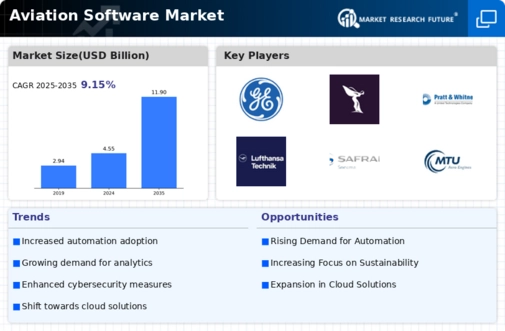Leading market players are investing heavily in research and development in order to expand their product lines, which will help the aviation software market grow even more. Market participants are also undertaking various strategic activities to expand their footprint, with important market developments including new product launches, contractual agreements, mergers and acquisitions, higher investments, and collaboration with other organizations. To expand and survive in a more competitive and rising market climate, the aviation software industry must offer cost-effective items.
Manufacturing locally to minimize operational costs is one of the key business tactics manufacturer use in the aviation software industry to benefit clients and increase the market sector. In recent years, the aviation software industry has offered some of the most significant technological advancements.
Major players in the aviation software market, including GE Aviation (U.S.), Rolls-Royce (U.K.), Pratt and Whitney (U.S.), Lufthansa Technik (Germany), Safran Aircraft Engines (Paris), SIA Engineering Company (Singapore), Air France Industries KLM Engineering and Maintenance (France), MTU Aero Engines (Germany), ST Aerospace (Singapore), Delta Tech-Ops (U.S.), and others, are attempting to increase market demand by investing in research and development operations.
GE Aerospace is the industry standard for jet and turboprop engines and other integrated systems for aircraft in the commercial, military, general aviation, and general aviation markets. Building a civilization that can last for generations is a challenge we're ready to take on. In the past 70 years, GE Aerospace and its subsidiaries have installed engines in more than 40,000 civilian and 26,000 military aircraft. In April 2023, GE Aerospace and Lockheed Martin signed a worldwide agreement for GE Aerospace to provide maintenance and repair services for F-35 avionics and electrical power systems.
Chris Newman, the F-35's senior program manager at GE Aerospace, says the company is still very focused on the plane's dependability and mission readiness.
Pratt & Whitney is unrivaled in producing and maintaining jet, helicopter, and auxiliary power unit engines. Pratt & Whitney is a leader in aircraft engine and auxiliary power system design, manufacturing, and service for commercial, military, and business aircraft. In 2020, the company's net sales were $17.2 billion, and the company's headquarters are located in East Hartford, Connecticut. The Raytheon Technologies Corporation consists of four separate companies, of which Pratt & Whitney is a part. More than 25% of all mainline passenger fleets worldwide are powered by Pratt & Whitney's large commercial engines.
With the help of its partners at International Aero Engines and the Engine Alliance, the company is constantly innovating new engines to suit the future demands of the airline industry. Pratt & Whitney has an impressive history of supplying cutting-edge engines to 29 militaries worldwide. The F-15 Eagle, F-16 Fighting Falcon, F-22 Raptor, and F-35 Lightning II are just a few front-line aircraft powered by our military engines. We also provide engines for the C-17 Globe Master III military transport and Boeing's KC-46, the new airlift tanker for the United States Air Force.
In March 2023, Mitsubishi Heavy Industries Aero Engines Ltd. (MHIAEL), a Japanese Aero Engine Corporation subsidiary, joined the Pratt & Whitney GTFTM MRO network as its second active facility in Japan and the eleventh overall. MHIAEL has introduced its first PW1100G-JM engine at its Komaki, Japan facility. MHIAEL has been a Pratt & Whitney maintenance partner since the Wasp engine and, most recently, the PW4000 and V2500 engines.

















